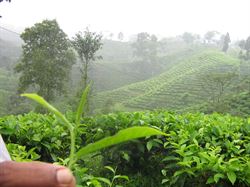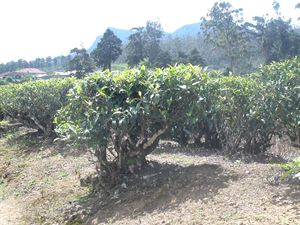Thea sinensis (or Chinese Tea)

This plant remains shrub-like even without regular cutting and grows to a maximum height of 3 to 4 meters. It is especially suitable for medium climatic zones and even tolerates frost. The China-tea plant has been cultivated for many thousand years which resulted in an art variety of approximately 5,000, which are, however, not all cultivated in notable amounts.
The first tea cultivation in India took place in the 19th century in the region Darjeeling with the Chinese camellia sinensis. After the discovery of the Assam pland in the rainforest of the Province Assam, people in India and Ceylon (Sri Lanka) started interbreeding these two tea plants in oder to gain synergies by adding the advanteages of each. Today, these hybrids are cultivated almost everywhere. With respect to economic considerations, the proportion of the Assam plant is kept as high as possible in these breds as it is quickly growing.
Thea assamica
Without cutting, this plant grows to a tree size of 15 to 20 metres. It needs warm temperatures and tropical climate. It was discovered in 1823 as a grown tree in the jungle of Northern India. Only a few years later it was already cultivated. The Assam plant requires hot and humid conditions and its leaves are larger than that of the China tea plant.
As is usual with a high-quality natural product, the tea plant, with its dark, ridged and leather-like leaves, is not humble with respect to its environmental demands. Its preferred climatic conditions can be described as the “camelia-climate”: average temperatures of at least 18°C, none or very rare frost, annual precipitation of at least 1,600 litres spread evenly over the year, an average sunshine of 4 hours daily and very well drained, permeable and acidic soil.

In order to create finer, more aromatic and more robust varieties, the two original plants were often interbred. The so-created Assam-hybrid proved especially adequate and provides the basis for almost all tea cultivations in the world today. Today, the plants are multiplied by cloning.
However, it is a mistake to believe that the differences in quality and taste are solely due to the diverse tea varieties in the plant itself. These characteristics are mainly determined by the cultivation area (climate, soil characteristics, altitude, …) and, of course, by the treatment and preparation on the respective plantations. A consistent quality standard is guaranteed by these different blends.
